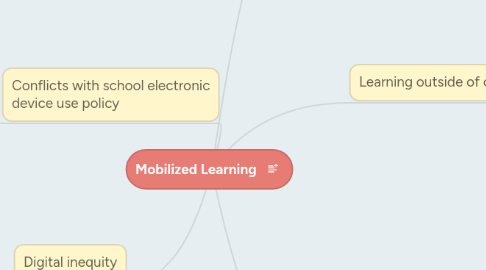
1. Conflicts with school electronic device use policy
1.1. student access to mobile devices was limited by school rules that prohibited the use of electronic devices during instructional hours
1.2. students having school-provided mobile devices extended their learning from school to home
1.3. boundaries between formal and informal learning spaces were blurred when students had access to mobile technologies
1.4. student-defined activities were seen as disruptive but may provide positive knowledge gains
2. Digital inequity
2.1. the integration of tablets in a Spanish school helped reduce socio-educational inequities among students
2.1.1. students with the worst academic records showed the most improvement when compared to their classmates
2.1.2. historically disadvantaged students benefitted academically from the use of tablets
3. Four primary affordances
3.1. a. offering students multiple entry points and learning paths and allowing for differentiated learning
3.2. b. enabling multiple modality via mobile devices by which students have a tool to create a different learning artifact to suit their needs
3.3. c. supporting student improvisation in situ—student may improvise as needed within the context of learning
3.4. d. supporting learning creation on the move with an ease of creating and sharing artifacts
4. Learning outside of classrooms
4.1. have explored the use of mobile learning in authentic settings outside the classroom
4.2. students could investigate location-specific phenomena and engage in content learning within context-specific, in situ, field lessons
4.3. students could explore and learn beyond the school setting, including field-based disciplines, such as geology, and in the observation of environmental changes
4.4. bring biological sciences out of the classroom
4.4.1. created and tested a system that allowed fifth graders to access learning materials via a PDA while studying plants in nature
4.4.2. investigated the potential of using mobile devices for learning science outdoors
4.4.3. the mobility allowed for active and mobilized learning of topics such as mathematics beyond the classroom setting
4.4.4. situated mobile learning research in a museum greatly improved students’ interest in museum displays
4.5. have explored the experiential learning potential that the devices can provide learners outside of the classroom environment
5. Expanding the school day
5.1. Anytime access can individualize learning by allowing students to work at their own pace, monitor their own progress, access additional help outside the classroom.
5.1.1. explored the impact of anytime access on student learning by creating and testing a multilayered learning environment that allowed students to work through guided and independent field observations with information access via PDAs
5.1.2. investigated the potential for mobile devices to support self-regulated learning by using a program based on the K-W-L graphic organizer
